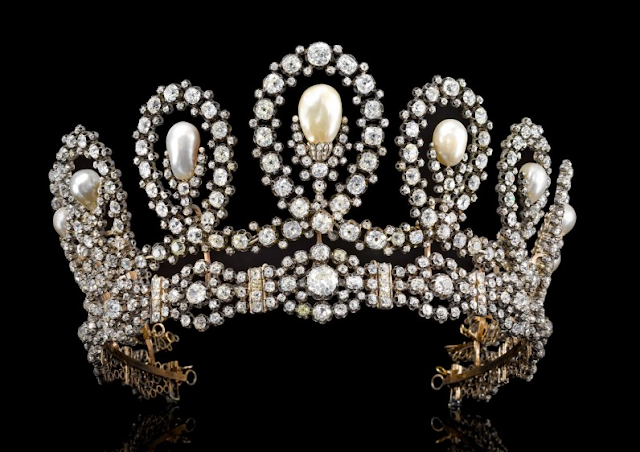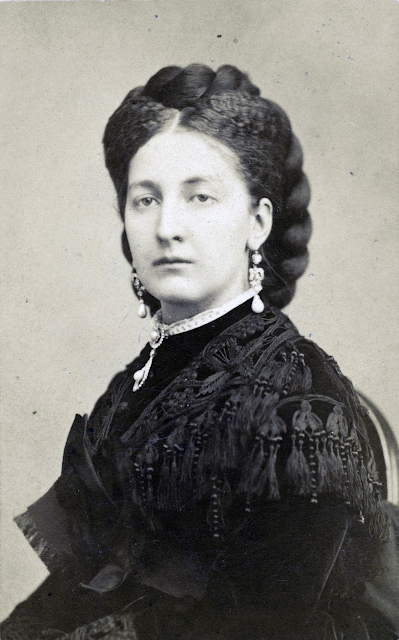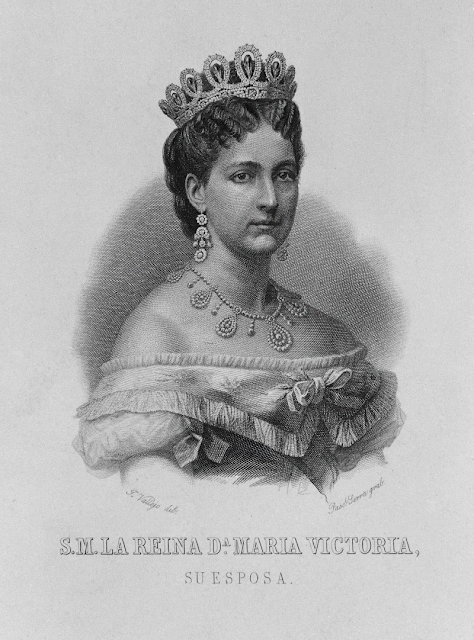 |
| Sotheby’s |
On May 11, Sotheby’s in Geneva will auction off a piece of glittering Italian royal history: a convertible diamond and pearl tiara that belonged to a woman who was both Duchess of Aosta and—very briefly—Queen of Spain. Today, we’ve got all the details on Queen Maria Vittoria’s Diamond and Pearl Tiara.
 |
| Sotheby’s |
The tiara dates to the second half of the nineteenth century. It was made by Musy, an established jewelry firm based in Turin that served at one point as the official jewelers of the Italian royals. The jewel features the Musy mark on the base of the tiara. You’ll be familiar with several of the family’s other Musy-made tiaras, including the magnificent pearl and diamond tiara and the Savoy Knot Tiara, both of which belonged to Queen Margherita of Italy. The grand Aosta Stars and Knots Tiara was made by Musy as well.
 |
| Sotheby’s |
The lot notes from the Sotheby’s auction describe the jewel as “composed of graduated scroll motifs set with cushion-shaped, circular- and single-cut diamonds, framing eleven slightly baroque drop-shaped natural pearls.” The central pearl is “supported by a rose diamond mount.” The detachable base of the tiara is “composed of cluster and bar motifs set with cushion-shaped diamonds.” When the base is removed, the top of the tiara can be worn separately as a necklace, as you can see in the image above.
 |
| Sotheby’s |
Here’s a look at the separated base and top portion, photographed side by side.
 |
| Sotheby’s |
And here, you can see the two elements joined together, allowing the piece to be worn as a tiara. In its complete form, the diamonds of the necklace portion curve to fit with the design of the tiara base.
 |
| Maria Vittoria dal Pozzo (Wikimedia Commons) |
The tiara’s first owner was Princess Maria Vittoria dal Pozzo, a member of an aristocratic Italian family from Turin. Maria Vittoria’s father, Carlo Emanuele dal Pozzo, was a Sardinian nobleman (the 5th Prince della Cisterna, among other titles) and politician. Her mother, Countess Louise de Merode, was a Belgian aristocrat (and a sister-in-law of Prince Charles III of Monaco). Maria Vittoria was born in Paris in 1847, during a time of immense political upheaval across the European continent. Her father had been exiled from Sardinia as a result of his support for the Italian unification movement in his youth. In 1848, just before King Vittorio Emanuele II succeeded to the Sardinian throne, Maria Vittoria and her family were allowed to return to her father’s native country. Carlo dal Pozzo became a senator, drawing him close to the center of power in Turin. He was at the heart of politics when King Vittorio Emanuele became the monarch of all of Italy in 1861.
In 1864, when Maria Vittoria was still a teenager, the family suffered a pair of tragedies: the loss of her only sister, 13-year-old Princess Beatrice, and the death of her father, Carlo. As the eldest and only surviving child of the family, Maria Vittoria suddenly inherited all of her father’s titles, becoming (among others) the Princess della Cisterna, Princess di Belriguardo, and Marchioness di Voghera in her own right. She also inherited her father’s vast fortune. The young princess was popular, and newspaper reports from the time describe her as “very talented in every branch of science.”
 |
| Amedeo and Maria Vittoria, 1867 (Wikimedia Commons) |
Three years after her father’s death, Princess Maria Vittoria made a match that vaulted her into an even higher social echelon. On May 30, 1867, she married Prince Amedeo, Duke of Aosta, the second son of King Vittorio Emanuele II, in the chapel at the Royal Palace in Turin. Her new father-in-law had initially opposed the marriage. Though she held the title of “princess,” Maria Vittoria was noble, not royal. King Vittorio Emanuele had hoped his son would marry a German or Austrian princess, further linking them to other European royal families. But he eventually gave his consent, and even offered Maria Vittoria a dazzling present (a pearl necklace with a diamond and sapphire clasp) on her wedding day.
 |
| Sotheby’s |
The new Duchess of Aosta now had both royal rank and an enormous fortune, and she quickly amassed a jewelry collection appropriate for her lifestyle. Like her sister-in-law, Margherita, Maria Vittoria was fond of pearls. We don’t seem to know precisely when the Musy tiara entered Maria Vittoria’s jewelry collection, but it must have been shortly after her royal wedding.
In 1870, a political decision changed the course of Maria Vittoria’s life. Across the sea in Spain, a revolution had ousted the nation’s monarch, Queen Isabella II. On November 16, 1870, Maria Vittoria’s husband was elected to serve as the new King of Spain by the country’s legislature. Spanish politicians had searched Europe for a royal who was willing to be democratically elected. The prime minister, Juan Prim, had settled on Amedeo, who already had one heir (Prince Emanuele Filiberto) and another child on the way, as the best possible choice. Amedeo agreed. After Maria Vittoria gave birth to their second son, Prince Vittorio Emanuele, on November 24, the family headed for Madrid, where the couple became King Amedeo I and Queen Maria Vittoria of Spain.
 |
| An engraving of Queen Maria Vittoria, featuring the tiara, from her brief time as Queen of Spain in the 1870s; the lot notes from Sotheby’s note that the tiara is depicted here with emeralds, adding, “Whether this is the creator’s fantasy, or the jewel’s versatility, it is a mystery that remains unsolved” (Sotheby’s) |
Things for the Aostas in Spain were rocky from the start. The prime minister who had championed Amedeo’s choice was assassinated before Amedeo was even sworn in as the country’s new king. Spain was in turmoil, with uprisings regularly happening in various parts of the country. Maria Vittoria wisely stayed in the background during her time in Spain; her husband, who didn’t have the same luxury, was often brought into the middle of disputes—and, on one occasion, narrowly escaped assassination himself. Shortly after Maria Vittoria gave birth to their third child, Prince Luigi Amedeo, at the Royal Palace in Madrid, King Amedeo abdicated in February 1873, taking his family back to Italy.
 |
| Sotheby’s |
The political upheaval, combined with the effects of three pregnancies and births, proved too much for Maria Vittoria’s health. Suffering from tuberculosis, she died on November 8, 1876, in the coastal city of Sanremo. She was only 29.
Precisely what happened to the diamond and pearl tiara after Maria Vittoria’s death remains unclear. The piece was almost certainly inherited by one of her three sons. Because the wife of the eldest son, the Duke of Aosta, never wore the tiara, Sotheby’s writes that “historians assume that it must have gone to one of her other sons, either the Count of Turin or the Duke of the Abruzzi, both of whom died without descendants.” The lot notes add, “It is known that King Umberto II of Italy bought the jewel from one of his cousins to prevent this historic piece from leaving the family collection.”
 |
| Sotheby’s |
In recent years, King Umberto II’s daughter, Princess Maria Gabriella of Savoy, has been photographed wearing the jewel in its necklace setting. In 2007, the princess sold a large collection of jewels that had belonged to her mother, Queen Marie Jose, at Christie’s in London. That sale included the Leuchtenberg Faberge Tiara and the Baden Seed Pearl Tiara, as well as numerous other important jewels.
 |
| Sotheby’s |
This time around, Sotheby’s is simply saying that the convertible tiara/necklace comes from “a European royal family,” confirming in the lot notes that the tiara has “remained in the family” following the purchase by King Umberto II.
 |
| Sotheby’s |
The tiara will be sold on May 11, 2021, in its Magnificent Jewels and Noble Jewels sale from Geneva. (You can see the other lots from the auction here; there are some remarkable pieces included.) The pre-auction estimate for the tiara is set at 940,000-1,400,000 Swiss francs. As of today’s writing, that converts to approximately $1,016,260-1,513,579 USD. The tiara is one of the marquee items from the auction, and they’re clearly betting on some major bang for their bucks from its royal provenance.
 |
| Sotheby’s |
While we wait to see how much the remarkable royal heirloom sells for at auction, Sotheby’s has also provided us a fun activity using a bit of modern technology. On your mobile device, head over to the official Sotheby’s Instagram account, where you’ll find a highlight labeled “Royal tiara.” There, you can “try on” the jewel using a specially created filter effect. The scale is a little off, but it’s still quite fun to see yourself wearing an important piece of royal jewelry!
Leave a Reply